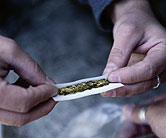
FRIDAY, Jan. 8 (HealthDay News) — Almost 5 percent of aging Baby Boomers in the United States are abusing drugs, a new government report shows.
That’s about 4.3 million adults over the age of 50 who are smoking marijuana, abusing prescription medication and engaging in other illicit drug activity — a number that far exceeds that of their parents’ generation.
“This is becoming more and more apparent in practice,” said Dr. Ihsan M. Salloum, chief of the Division of Alcohol and Drug Abuse: Treatment and Research at the University of Miami Miller School of Medicine. “You have both prescription drugs being used that people can become addicted to and also people who have had a pattern of use from before.”
The driving force behind the trend, said Peter Delany, director of the Office of Applied Studies at the U.S. Substance Abuse and Mental Health Services Administration (SAMHSA), is people who used drugs when they were younger and never really stopped.
This is, after all, the era of the Rolling Stones as senior citizens.
The projected increase in the number of older drug abusers is expected to double the demand for treatment services by 2020, the report stated.
The report, based on data collected during 2006-08 from almost 20,000 U.S. adults born between 1946 and 1964, found that more men are smoking marijuana than are abusing prescription drugs (4.2 percent vs. 2.3 percent). About the same proportion of women engage in both behaviors (hovering near 2 percent).
Many more men aged 50 to 54 acknowledged using marijuana in the previous year than women (8.5 percent vs. 3.9 percent).
Pot smoking was more prevalent among the younger end of the spectrum (those aged 50 to 59), while prescription drug abuse was more common in the older age bracket (aged 65 and up).
Less than 1 percent of older adults said they had used drugs other than pot or prescription-like medications, including 0.5 percent for cocaine, 0.1 percent for hallucinogens and 0.1 percent for heroin.
In the period 2002-06, the annual average number of people over the age of 50 using illicit drugs was 2.8 million.
Although “harder” drugs such as crystal meth and cocaine aren’t the main offenders in this demographic, drug use among older, generally more frail, individuals does bring special concerns.
“This population tends to have other health problems, especially chronic health problems,” Delany explained. “And as we age we don’t metabolize drugs the same way.”
Also, older people with a substance-abuse diagnosis are much more at risk of suicide, said Dr. David Schlager, clinical assistant professor of psychiatry and behavioral science at Texas A&M Health Science Center College of Medicine and a psychiatrist with Lone Star Circle of Care, which has health clinics throughout Texas.
Finding appropriate treatments for this group adds more potential complications.
“We don’t really have data and research for the most effective treatments for older individuals,” said Jeffrey Parsons, chair of psychology at Hunter College in New York City. “Are existing programs effective or do we need to start from scratch?”
And the two different groups of older drug users — those with new addictions and those with long-term issues — may need different treatments, he added.
Not to mention the inherent limitations in drug abuse treatment and services as they currently stand. “The treatment is not terrible advanced,” Schlager noted.
On the other hand, Schlager said, Baby Boomers may be in a better position both to access what services there are and to pay for them.
More information
Visit the U.S. Substance Abuse & Mental Health Services Administration for more on this problem.

